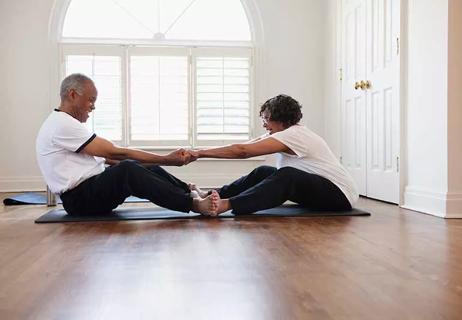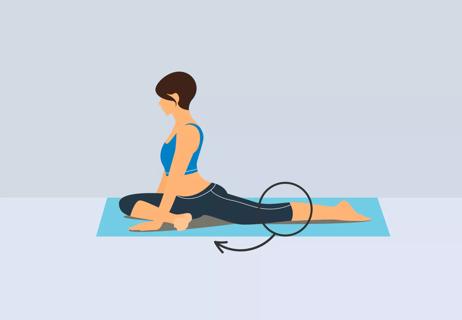Simply contracting certain muscles provides a good stretch to other areas of your body

Stretching seems easy enough — for example, bending over and touching your toes. And you’ve probably done a stretch or two before or after a workout.
Advertisement
Cleveland Clinic is a non-profit academic medical center. Advertising on our site helps support our mission. We do not endorse non-Cleveland Clinic products or services. Policy
But did you know that there are many forms of stretching? And that you can reap benefits like improving your flexibility and increasing your range of motion by stretching a few times a week?
While many of us probably aren’t working stretching into our daily to-do lists, one form of stretching called active stretching is an easy way to get started, as it just requires using your body.
Exercise specialist Ben Kuharik explains active stretching, its benefits and how to do it.
Active stretching, also known as static active stretching, uses your own muscles to provide resistance. With an active stretch, you’re moving or contracting one muscle to stretch another. And as you’re using your own muscles, there’s no external force like equipment or other people required.
So, what’s the difference between active stretching and other forms of stretching? The key to active stretching is holding each pose for about 15 seconds instead of going through a range of motion like shoulder circles, which is considered a dynamic stretch.
Passive stretching is similar to active stretching, but with these moves, you tend to use an external force like a person or a prop like a towel to aid in your stretch.
“Active stretching involves reciprocal inhibition,” explains Kuharik. “That’s when one muscle called the agonist, is used to stretch the opposing muscle, which is known as the antagonist.”
Advertisement
And the likelihood of an injury while active stretching is low. Your body won’t allow or force you to go beyond a point that you can’t handle.
Stretching can be good for a number of reasons. Here are some active stretching benefits:
We’re not saying you need to be able to do the splits, but staying flexible can help your overall health as you age.
Research shows that having a stretching routine will help you move around more comfortably (think going up and down stairs) and can keep your muscles and joints strong and healthy in the long run.
And as we age, the risk of falling increases. But research shows that active stretching may be an effective way for older adults to improve their overall balance.
“When you’re walking, you don’t want your feet close together — you want a wide base of support,” says Kuharik. “But over time people tend to develop a narrower walking stance, which can lead to falls. Your muscles become chronically tight and you just don’t even realize it.”
By incorporating active stretching into your daily routine, you’re keeping your muscles strong and flexible — and maintaining a wider walking stance, which helps with fall prevention.
Feeling sore after a strenuous workout? Stretching may help improve circulation, which increases blood flow in your muscles. That all adds up to a way to reduce muscle soreness and help recover more quickly post-workout.
“If you stretch the areas you’ve just worked out, your blood flows more freely and boosts the amount of oxygen and nutrients that reach your muscles,” explains Kuharik. “Stretching helps flush out the toxins in your muscles. If you spend just a few minutes stretching, it helps remove any lactic acid build-up, which can cause delayed onset muscle soreness.”
According to studies, sticking to a stretching routine may also help with your posture by strengthening your muscles and promoting proper alignment.
“We’re sitting all day — especially in this day and age — on our computers, on our phones,” notes Kuharik. “When you sit for chronic periods of time, your body wants to adapt to that position and thinks it’s the new norm. Then, you stand up and you’re essentially stretching all those muscles out and your body doesn’t like it. It wants to conform back to the seated position.”
So, what can we do?
“You need to take a little bit of extra time and just stretch out all those muscles,” says Kuharik. “By constantly flexing and stretching those muscles, they learn to go back to their natural position.”
As active stretching doesn’t require a partner or any equipment, it’s easy to do. And while active stretching is mostly used after a workout, it doesn’t need to happen in conjunction with exercise. You can do it anytime, anywhere.
Advertisement
“You don’t need to spend a lot of time doing active stretching,” says Kuharik. “For example, I spend maybe two to five minutes after every workout. I just spend a few minutes on the targeted area and that does the job.”
Another plus? You don’t need to warm up before engaging in an active stretch. “It can fit into your lifestyle,” he adds. “You could stretch sitting at your desk.”
And if you’re a fan of yoga? You’re already engaging in active stretching by holding certain poses for a few seconds at a time.
Here are a few active stretches you can try:
Advertisement
Overall, active stretching can be a great way to work on your flexibility, range of motion and balance. And by using your own muscles to stretch other muscles, it can be easy to do anywhere and anytime.
“Remember, you don’t want to push your body past its natural range of motion,” cautions Kuharik. “You want to have a controlled motion and feel a good stretch that you can hold comfortably for a few seconds at a time.”
Advertisement
Learn more about our editorial process.
Advertisement

This satisfying, involuntary act of yawning and stretching helps release tight muscles

While one focuses on stretching through movement, the other requires holding poses for 30 to 90 seconds — both can have a place in your fitness routine

Stretch before and after your workouts for maximum benefits, but your pre-workout stretches should be different from your post-workout stretches

Having a partner help you stretch can prevent injury and lead to an increased range of motion

Relax into this form of stretching while a prop or partner assists you

Reduce pain and stiffness by stretching your body throughout the day

This extreme stretch can help build hip mobility and address pain in your back, knees and feet

Activities like swimming, cycling and rowing can get your heart pumping without stressing your joints

If you’re feeling short of breath, sleep can be tough — propping yourself up or sleeping on your side may help

If you fear the unknown or find yourself needing reassurance often, you may identify with this attachment style

If you’re looking to boost your gut health, it’s better to get fiber from whole foods